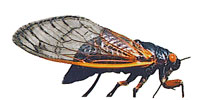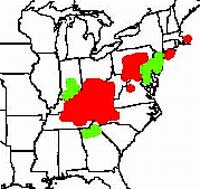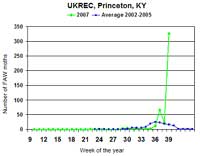


Capture of fall armyworm moths in the Princeton based IPM-pheromone baited traps have increased significantly. Last month I indicated in this newsletter that pastures in several Tennessee counties had suffered significant outbreaks of fall armyworm. At that time our counts were up slightly but then began to decline. This past week those captures increased significantly once again.
(See: http://www.uky.edu/Ag/IPMPrinceton/counts/fall/fawgraph.htm)
Counts for this Friday (05 Oct 07) were about 12 times the five year average for this date. This appears to be a west Kentucky population, as the traps in Lexington do not reflect this increase. While I can not say for sure that a fallworm outbreak will follow, certainly the risk has increased. With the temperatures we are currently experiencing, I expect that we will see larvae in about two weeks.
Wheat Concerns
While larvae (caterpillars) from the current moth flight will not be seen for a week or two (depending up temperature changes), there are fall armyworms present in some areas now. Calls from consultants and "ag-dealers" indicate that they and producers are wondering if they should control the caterpillars surviving on volunteer corn in fields that were / are going to be planted in wheat. This is a very good question.
1.) If the wheat has already been planted and will emerge soon, an insecticide application is your only control alternative. Wheat will tolerate considerable damage from fall armyworm, but there is no established threshold.
2.) If wheat has not been planted into the field, I do not think that the current crop of caterpillars that are surviving in the volunteer corn will be around when the wheat emerges. This is providing that the wheat is planted at the normally recommended time, using the Hessian fly-free date as a guide. For example, this would be Oct 15 for the southern tier of counties and up to Princeton, with progressively earlier dates as one moves north (See Hessian Fly in KY at: http://www.ca.uky.edu/entomology/dept/entfacts.asp).
From a purely "insect control" standpoint, it appears to me that controlling the volunteer corn would accomplish the same insect control, and might have some additional favorable agronomic impacts. However, it is important to understand that the corn must be killed quickly, in order to obtain insect control. I do not think mowing is an option. If the corn dies, the caterpillar's food source is gone and they will die, or perhaps try to move. I would NOT suggest this tactic if the field is heavily infested with fall armyworm and adjacent fields contain another host crop like, small grains, grass hay or alfalfa. This is particularly, important for new plantings. They are after all "ARMY" worms. They can move.
3.) Regardless of whether one tries to control the current fall armyworm population by destroying the volunteer corn or with an insecticide application, neither of these techniques will have any impact on the caterpillars that will result from egg laying that will occur in the future. This is why the current moth flight (and weather) may be important.
4.) Normally, weather is the main source of control for fall armyworm. It may turn out to be this way again this year. If the weather turns cool and we get a frost at a reasonable time, all of this will be over and done with and no control action would be required by producers. If the weather does not cooperate then the problem will persist.
This wheat planting season is at higher risk to fall armyworm than in most years for three reasons: 1.) a much larger than normal population of fall armyworm moths, 2.) considerable volunteer corn in fields to be planted to wheat, which serves as an attraction to the moths and a host for the larvae, 3.) very warm weather. The most important technique is to watch your fields for fall armyworm so that you will not be caught of your guard. Remember, this pest has a wide host range and will remain a threat until a hard frost (especially in no-till). Even if you are not yet seeing larvae (caterpillars), certainly you should keep your eyes open for this pest on any newly seeded grasses or alfalfa.

There have been a large number of insecticide changes this past year. Those listed below will be incorporated into next version of ID-36 which is scheduled to be released in January 2008.
New Products
Radiant SC - spinetoram - IRAC group 5. This is controls larvae of Lepidoptera, Diptera, and thrips. Labels on a wide range of vegetables including asparagus, legume vegetables, cole crops, cucurbits, sweet corn, eggplant, peppers, potatoes, tomatoes, root crops, and leafy greens. REI of 4 hours.
Renounce 20WP (RUP) - cyfluthrin - IRAC Group 3. This is a broadspectrum insecticide labeled for use on brassica leafy vegetables, cucurbits, potatoes, tomatoes, peppers, eggplant, leafy vegetables, root vegetables, sweet corn, and dried shelled legume vegetables. REI of 12 hours.
Beleaf 50SG - flonicamid - IRAC Group 9C. Labeled for control of aphids, plant bugs, and greenhouse whitefly on head and stem brassicas, mustard greens, cucurbits, tomatoes, peppers, eggplant, leafy vegetables, and potato. REI of 12 hours.
Clutch 50WDG - clothianidin - IRAC Group 4. Labeled for control of Colorado potato beetle, aphids, and leafhoppers on potato.
Label Expansions
Acramite 4 - New uses for potato.
Actara 25W - New uses include cole crops, cucurbits, eggplant, leafy greens, and tomato.
AgriMek - New uses include lettuce and spinach.
Avaunt - New uses include cucurbits and southern peas.
Baythroid XL - New uses for eggplant.
Dimilin 2L - New uses include some leafy greens,
Fulfill - New uses for asparagus.
Mustang Max - New uses include cucurbits, potato and sweet potato.
Rimon 0.83EC - News uses for cole crops.
Syngenta Crop Protection has announced that the EPA has approved the use of Dividend Extreme on sweet corn for suppression of damping-off caused by Pythium spp. and post-emergence dieback, caused by fungal species such as Rhizoctonia solani and Fusarium spp. Dividend Extreme is a seed treatment, and is a mixture of mefenoxam (the same active ingredient found in Ridomil Gold) and difenoconazole. Difenoconazole is a triazole fungicide belonging to the class of compounds known as sterol-biosynthesis inhibitors; the combination of mefenoxam and difenoconazole creates a product with activity against a broad spectrum of plant pathogens.
The use rate for Dividend Extreme is 2 to 5 fl oz per 100 lb of seed. To apply, create a slurry by mixing the product in enough water to provide thorough and uniform coverage of seed with standard seed-treatment equipment. Agitate the slurry constantly during the treatment process, and allow seed to dry before bagging. Do not use pesticide-treated seed for food, feed, or oil.

The unusually dry weather this season has affected many things including the persistence of herbicides in soil. However, it remains unclear if the effects of dry weather will cause herbicides to persist at sufficient levels to cause injury to rotational crops. Based on observations from previous dry seasons, injury due to "herbicide carryover" has been minimal in Kentucky relative to other areas. The fact this year's drought has set records in duration and severity makes the current situation unique.
The following factors should be considered in making decisions for planting certain crops this fall or next spring:
The University of Kentucky Regualtory Services offers a service for analyzing soil for triazine herbicides (atrazine & simazine) for interpretation of risk of injury to tobacco. Consult with your local county Extension office for specific details on collecting soil for triazine herbicides. There are also private companies that will analyze soil for atrazine and simazine as well as other specific herbicides. Two companies that analyze for herbicides are:
Waters Agricultural Laboratories in Owensboro KY
270-685-4039
http://watersag.com/Ownesboro.htm
A & L Laboratories Memphis TN.
Ph: 800-264-4522
http://www.al-labs.com/
SOURCES OF INFORMATION:
The herbicide label is the ultimate source on defining safe options for rotating crops.
The UK extension publication AGR-6 has a section for crop rotational guidelines for specific herbicides used in grain crops and tobacco. http://www.uky.edu/Ag/Agronomy/Weeds/agr6/6X-End-06/112Rotation-2006.pdf
Another source is the publication on "Herbicide Persistence and Carryover in Kentucky (AGR-139)
http://www.ca.uky.edu/agc/pubs/agr/agr139/agr139.htm


This summer, white pines were observed in various states of decline and death in landscapes in several central Kentucky locations. In some cases, newly planted pines simply did not become established during their hot, dry first season in the landscape. In at least one case, Phytophthora root rot was prevalent in a white pine Christmas tree planting. However, in some landscapes, well-established previously healthy 10-20 year-old white pines were dying. White pine decline and white pine root decline were both observed this summer.
What causes white pine decline and white pine root decline?
Symptoms.
Disease management.
White pines are native to some parts of eastern Kentucky where they grow in moist sites with acid, sandy, soils. In other parts of Kentucky, there are exceptional long-lived white pines growing out of their native sites and why these survive while others nearby decline is not known. Creating good growing conditions before planting white pines is a good practice. White pine root decline is not curable and may be difficult to prevent in some sites. The fungus is probably more widespread in white pines than obvious symptoms would indicate. White pine root decline is known to be more of a problem for pines that are growing in stressful circumstances such as root and trunk wounding, air pollution exposure, and infection by other root decay fungi. In addition, the fungus can be vectored by trunk and root collar boring weevil insects, but their exact role here is not well defined. However, if white pines are being planted in landscapes to last a long time, premature decline and death is a risk that must be considered in most Kentucky locations. The best advice is to provide white pines with good growing conditions.

 Brood XIV of the periodical cicada is scheduled to emerge over most of Kentucky and surrounding states in 2008. Emergence should begin about mid-May with egg-laying starting about two weeks later. According to a 1991 issue of Kentucky Pest News, the cicada was active in 87 counties over the eastern 2/3 of the state (see map). Populations varied greatly by location, even within a county. Damage from this insect is inflicted on tree branches and twigs when females start to lay eggs. In addition, there was a substantial increase in infestations
of the woolly apple aphid at cicada wounds on apple trees in commercial and home orchards.
Brood XIV of the periodical cicada is scheduled to emerge over most of Kentucky and surrounding states in 2008. Emergence should begin about mid-May with egg-laying starting about two weeks later. According to a 1991 issue of Kentucky Pest News, the cicada was active in 87 counties over the eastern 2/3 of the state (see map). Populations varied greatly by location, even within a county. Damage from this insect is inflicted on tree branches and twigs when females start to lay eggs. In addition, there was a substantial increase in infestations
of the woolly apple aphid at cicada wounds on apple trees in commercial and home orchards.


September 28-October 5, 2007
UKREC-Princeton, KY
| Fall armyworm
| 326
| | |

This season insect trap counts will be provided for locations in Kentucky and Tennessee.
View trap counts for past seasons and the entire 2007 season at -
http://www.uky.edu/Ag/IPMPrinceton/Counts/2006trapsfp.htm
View trap counts for Fulton County, Kentucky at -
http://ces.ca.uky.edu/fulton/anr/
For information on trap counts in southern Illinois visit the Hines Report at -
http://www.ipm.uiuc.edu/pubs/hines_report/comments.html
The Hines Report is posted weekly by Ron Hines, Senior Research Specialist, at the
University of Illinois Dixon Springs Agricultural Center.
NOTE: Trade names are used to simplify the information presented in this newsletter. No endorsement by the Cooperative Extension Service is intended, nor is criticism implied of similar products that are not named.
Lee Townsend
Extension Entomologist